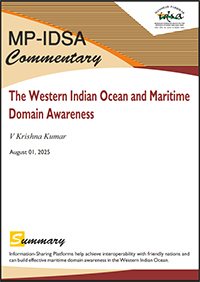The Western Indian Ocean and Maritime Domain Awareness
- August 01, 2025 |
- IDSA Comments
Given the vastness of the Indian Ocean, a shared information network enables efficient, cost-effective resource use. While concerns about the misuse of sensitive data persist, these risks will be minimised when sharing occurs between friendly nations with strong diplomatic and security ties. In such trusted environments, information sharing becomes more secure. Therefore, it is pivotal for like-minded nations to establish agreements that facilitate secure information sharing to strengthen collective maritime security.
The Western Indian Ocean (WIO) region, due to its vast expanse, presents a monumental challenge for a single nation or organisation to survey and monitor. This difficulty, geopolitical significance, and the rise of various maritime threats have created several Information Sharing Platforms (ISPs) in the WIO. These ISPs that came into existence at different points in the WIO, though varying on underlying factors, ultimately focus on enhancing maritime situational awareness in the WIO and beyond.
In 2012, the United States established the SeaVision platform to enhance MDA and serve as a multinational information-sharing tool. The Indo-Pacific Regional Information Sharing (IORIS) initiative, under the Critical Maritime Routes Indo-Pacific (CRIMARIO) framework, was established in 2015 and funded by the European Union (EU), with the primary focus on maritime capacity-building and exchange of information. In 2024, India established its information-sharing platform, Network for Information Sharing (NISHAR) and the MITRA terminals, which allow information exchange among friendly foreign countries (FFCs).[2]
Creating India’s ISP is key to achieving interoperability with other friendly nations and information-sharing networks like the SeaVision and IORIS. As stated above, these two systems have been operational in the WIO region for an extended period and, over time, have expanded their surveillance towards the Pacific. SeaVision and IORIS aim to provide a common operating picture (COP) through the collaborative spaces it has facilitated.[3] While their overall designs may differ, these platforms share overlapping features, such as messaging and chat functions, file sharing, notifications and mapping capabilities.
Most WIO littoral states, especially East African nations, are currently subscribed to these ISPs, particularly members of the Djibouti Code of Conduct (DCoC) like Kenya, Ethiopia, Tanzania, Somalia and Djibouti. Additionally, negotiations are ongoing with countries like South Africa and Egypt to integrate these platforms into their maritime security systems.
While India is formally not a part of the IORIS community, in April 2025, the U.S. State Department approved the potential sale of the SeaVision software to India. The deal, estimated to cost around US$ 131 million, includes software enhancements, Technical Assistance Field Team (TAFT) training, remote software, analytic support, access to SeaVision documentation, and related programme and logistics support.[4]
This opens up the possibility of technical and procedural interoperability between India’s NISHAR-MITRA and the SeaVision platform. While achieving technical compatibility is a difficult task, it is worth noting that IORIS and SeaVision have executed it over the years, with the SeaVision platform made accessible to IORIS users.[5] Although concerns over data sensitivity persist in India, the potential acquisition of the U.S. software paves the way for future interoperability. This aspect resonates with the Indian Navy’s maritime security strategy 2015, which points out that such “networked systems” will enhance monitoring by expanding to neighbouring regions and “coordinating with similar initiatives by other nations”.[6]
India has taken measures to develop its MDA capabilities over the last decade, with initial attention given to information sharing and MDA, which is visible in India’s maritime strategy (2015). The doctrine stated that the challenge of developing MDA would be addressed through various measures and achieved by developing networked systems capable of “linking and comparing all information received, including data from commercial sources”. This was followed by the creation of the Information Fusion Centre-Indian Ocean Region (IFC-IOR) in December 2018, together with the Information Management and Analysis Centre (IMAC),[7] which was established soon after the 26/11 Mumbai attacks to enhance India’s MDA and is jointly administered by the Indian Navy and Indian Coast Guard.
The IFC-IOR, aligned with India’s SAGAR (Security and Growth for All in the Region) vision, aims to ensure collective maritime security by acting as a regional hub for information exchange. It facilitates a common understanding of maritime situations by collecting and sharing data with partner nations. The centre hosts 14 International Liaison Officers (ILOs), with more countries showing interest in participation. It has established linkages with the Information Fusion Centre (IFC) in Singapore, the Regional Maritime Information Fusion Centre (RMIFC) in Madagascar, and the Regional Centre for Operational Coordination (RCOC) in Seychelles. White Shipping agreements with over 20 countries strengthen its role in maritime surveillance. The centre consistently generates reports to assist stakeholders in analysis and operational planning. Since its inception, it has demonstrated its effectiveness by relaying information to various stakeholders, enabling the timely prevention of potential threats.[8]
Despite the existence of such ISPs, challenges persist. Concerns over the sharing of sensitive data remain, and even though these can be mitigated through collaboration with FFCs, low levels of trust and transparency in some cases could limit cooperation. Duplication and overlapping functions and features of ISPs pose another limitation, which could result in operational inefficiencies. When similar maritime data is disseminated without coordination or interoperability, it can lead to redundancy and a fragmented situational picture. Given that the WIO is a vast region, having more ISPs only adds to the maritime security framework.
The Indian Ocean region is experiencing rapidly evolving dynamics and the emergence of new non-traditional, asymmetric and hybrid threats. In this context, information sharing is beneficial and essential. Therefore, regional leaders like India must continue to partner with friendly countries to promote and augment MDA in the WIO region. These ISPs play a pivotal role by serving as a hub for real-time information exchange and coordinating with liaison officers from partner nations. NISHAR-MITRA and the possible acquisition of SeaVision can only be expected further to enhance shared situational awareness across the Indian Ocean region.
Views expressed are of the author and do not necessarily reflect the views of the Manohar Parrikar IDSA or of the Government of India.
[1] Christian Bueger, “A Glue That Withstands Heat? The Promise and Perils of Maritime Domain Awareness”, in E.R. Lucas et al. (eds), Maritime Security: Counter-Terrorism Lessons from Maritime Piracy and Narcotics Interdiction, IOS Press, 2020.
[2] “Global Community Must Collectively Aspire for Peace in this Age of Democratic & Rules-based World Order: Raksha Mantri Shri Rajnath Singh at Exercise MILAN in Visakhapatnam”, Press Information Bureau, Ministry of Defence, Government of India, 21 February 2024.
[3] “The SeaVision and IORIS Platforms: Working in Complementarity”, Djibouti Code of Conduct, 29 January 2024.
[4] “India – Indo-Pacific Maritime Domain Awareness”, Defense Security Cooperation Agency, Department of Defense, United States, 30 April 2025.
[5] Katia Maronati, “IORIS v 2.0 is available”, Critical Maritime Routes Programme II, European Union, 10 November 2019.
[6] “Ensuring Secure Seas: Indian Maritime Security Strategy”, Indian Navy, Ministry of Defence, Government of India, October 2015.
[7] Captain Himadri Das, “Maritime Domain Awareness in India: Shifting Paradigms”, National Maritime Foundation, 30 September 2021.
[8] “Home | IFC-IOR”, Indiannavy.gov.in.






